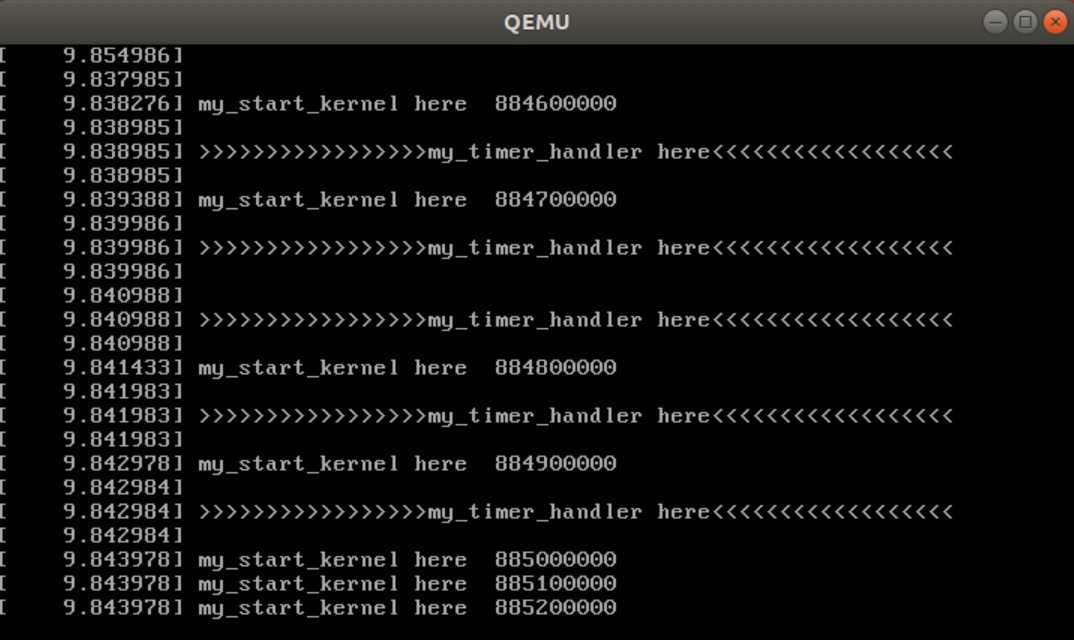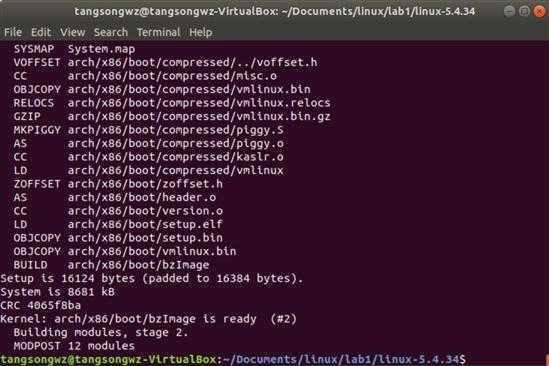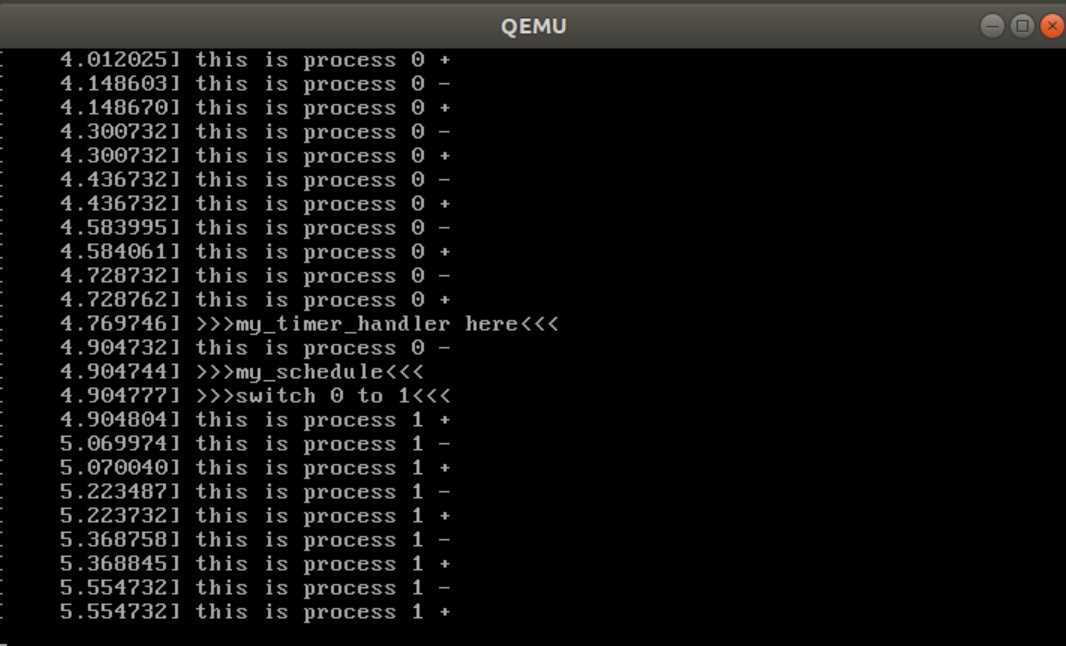配置mykernel 2.0,熟悉Linux内核的编译
(1)首先需要配置虚拟环境,本次实验采用Virtual Box + Ubuntu 18.04.2 LTS完成虚拟环境配置。
wget https://raw.github.com/mengning/mykernel/master/mykernel-2.0_for_linux-5.4.34.patch
sudo apt install axel
axel -n 20 https://mirrors.edge.kernel.org/pub/linux/kernel/v5.x/linux-5.4.34.tar.xz
xz -d linux-5.4.34.tar.xz
tar -xvf linux-5.4.34.tar
cd linux-5.4.34
patch -p1 < ../mykernel-2.0_for_linux-5.4.34.patch
sudo apt install build-essential libncurses-dev bison flex libssl-dev libelf-dev
make defconfig # Default configuration is based on ‘x86_64_defconfig‘
make -j$(nproc)
sudo apt install qemu # install QEMU
qemu-system-x86_64 -kernel arch/x86/boot/bzImage
(2)通过运行以上命令从而成功启动执行程序,从QEMU窗口输出的内容可以看到输出 my_start_kernel here 和 my_timer_handler here。

(3)通过mymain.c和 myinterrupt.c 程序可以看出 mymain.c 通过每次计数达到100000输出一次my_start_kernel here从而不停的执行。同时还具有一个中断处理程序的上下文环境,周期性的产生时钟中断信号,触发myinterrupt.c程序执行输出 my_timer_handler here。这样就通过Linux内核代码模拟了一个具有时钟中断和C代码执行环境的硬件平台。


基于mykernel 2.0编写一个操作系统内核
(1)接下来需要在 mymain.c 的基础上继续写进程描述PCB和进程链表管理等代码,在 myinterrupt.c 的基础上完成进程切换代码,才可以完成一个简单的操作系统内核从而进行进程调度。
(2)首先进入 mykernel 文件夹,然后通过使用 touch 命令新建一个mypcb.h文件, 并复制相应代码。同时利用 GitHub 上的 mymain.c 和 myinterrupt.c 文件替代原先文件。
(3)使用 make 指令重新编译,并运行 qemu-system-x86_64 -kernel arch/x86/boot/bzImage指令。即可观察到进程的切换调度过程。


简要分析操作系统内核核心功能及运行工作机制
(1)进程控制块mypcb.h分析
#define MAX_TASK_NUM 4
#define KERNEL_STACK_SIZE 1024*8
/* CPU-specific state of this task */
struct Thread {
unsigned long ip;
unsigned long sp;
};
typedef struct PCB{
int pid;
volatile long state; /* -1 unrunnable, 0 runnable, >0 stopped */
char stack[KERNEL_STACK_SIZE];
/* CPU-specific state of this task */
struct Thread thread;
unsigned long task_entry;
struct PCB *next;
}tPCB;
void my_schedule(void);
MAX_TASK_NUM 指定进程的数目
KERNEL_STACK_SIZE 指定进程堆栈空间大小
struct Thread 用来定义进程结构体,其中ip为指令指针,sp为栈顶指针
struct PCB 用来定义进程控制块结构体
1. pid为进程id
2. state为进程当前状态,-1代表阻塞态,0代表可运行态,>0代表暂停状态
3. stack[KERNEL_STACK_SIZE]为进程堆栈
4. thread为保存进程指令指针和栈顶指针的变量
5. task_entry为进程的程序入口地址
6. next为执向下一进程控制块的指针,即进程控制块通过链表数据结构存储
(2)mykernel内核代码的入口,负责初始化内核的各个组成部分的 mymain.c 文件分析
#include <linux/types.h>
#include <linux/string.h>
#include <linux/ctype.h>
#include <linux/tty.h>
#include <linux/vmalloc.h>
#include "mypcb.h"
tPCB task[MAX_TASK_NUM];
tPCB * my_current_task = NULL;
volatile int my_need_sched = 0;
void my_process(void);
void __init my_start_kernel(void)
{
int pid = 0;
int i;
/* Initialize process 0*/
task[pid].pid = pid;
task[pid].state = 0;/* -1 unrunnable, 0 runnable, >0 stopped */
task[pid].task_entry = task[pid].thread.ip = (unsigned long)my_process;
task[pid].thread.sp = (unsigned long)&task[pid].stack[KERNEL_STACK_SIZE-1];
task[pid].next = &task[pid];
/*fork more process */
for(i=1;i<MAX_TASK_NUM;i++)
{
memcpy(&task[i],&task[0],sizeof(tPCB));
task[i].pid = i;
task[i].thread.sp = (unsigned long)(&task[i].stack[KERNEL_STACK_SIZE-1]);
task[i].next = task[i-1].next;
task[i-1].next = &task[i];
}
/* start process 0 by task[0] */
pid = 0;
my_current_task = &task[pid];
asm volatile(
"movq %1,%%rsp\n\t" /* set task[pid].thread.sp to rsp */
"pushq %1\n\t" /* push rbp */
"pushq %0\n\t" /* push task[pid].thread.ip */
"ret\n\t" /* pop task[pid].thread.ip to rip */
:
: "c" (task[pid].thread.ip),"d" (task[pid].thread.sp) /* input c or d mean %ecx/%edx*/
);
}
int i = 0;
void my_process(void)
{
while(1)
{
i++;
if(i%10000000 == 0)
{
printk(KERN_NOTICE "this is process %d -\n",my_current_task->pid);
if(my_need_sched == 1)
{
my_need_sched = 0;
my_schedule();
}
printk(KERN_NOTICE "this is process %d +\n",my_current_task->pid);
}
}
}
其中__init my_start_kernel函数首先对0号进程进行初始化,其中包括将进程的pid设置为对应的序号,进程的状态设置为可运行态,进程的程序入口地址设置为my_process 函数,进程的栈顶指针为该进程的堆栈栈底,进程执行下一进程的指针初始化为指向自身。接下来继续初始化剩余进程并将进程通过链表形式来进行链接,其中各进程之间的 pid 和栈顶指针以及指向下一进程的指针都不相同。最后通过汇编代码来启动0号进程,将指令指针ip存入ecx寄存器,将栈顶指针sp存入edx寄存器,进程的栈顶指针的值赋给esp寄存器,将栈顶地址sp、进程指令指针ip入栈,最后将ip指令指针出栈保存至esp寄存器,跳转至进程入口函数开始运行0号进程。
接下来的my_process函数是通过进程运行完一个时间片后主动让出CPU的方式,通过判断my_need_sched的值来决定是否调用my_schedule()函数来进行进程之间的切换。
(3)负责进程切换和时间片计数的myinterrupt.c文件分析
#include <linux/types.h>
#include <linux/string.h>
#include <linux/ctype.h>
#include <linux/tty.h>
#include <linux/vmalloc.h>
#include "mypcb.h"
extern tPCB task[MAX_TASK_NUM];
extern tPCB * my_current_task;
extern volatile int my_need_sched;
volatile int time_count = 0;
/*
* Called by timer interrupt.
* it runs in the name of current running process,
* so it use kernel stack of current running process
*/
void my_timer_handler(void)
{
if(time_count%1000 == 0 && my_need_sched != 1)
{
printk(KERN_NOTICE ">>>my_timer_handler here<<<\n");
my_need_sched = 1;
}
time_count ++ ;
return;
}
void my_schedule(void)
{
tPCB * next;
tPCB * prev;
if(my_current_task == NULL
|| my_current_task->next == NULL)
{
return;
}
printk(KERN_NOTICE ">>>my_schedule<<<\n");
/* schedule */
next = my_current_task->next;
prev = my_current_task;
if(next->state == 0)/* -1 unrunnable, 0 runnable, >0 stopped */
{
my_current_task = next;
printk(KERN_NOTICE ">>>switch %d to %d<<<\n",prev->pid,next->pid);
/* switch to next process */
asm volatile(
"pushq %%rbp\n\t" /* save rbp of prev */
"movq %%rsp,%0\n\t" /* save rsp of prev */
"movq %2,%%rsp\n\t" /* restore rsp of next */
"movq $1f,%1\n\t" /* save rip of prev */
"pushq %3\n\t"
"ret\n\t" /* restore rip of next */
"1:\t" /* next process start here */
"popq %%rbp\n\t"
: "=m" (prev->thread.sp),"=m" (prev->thread.ip)
: "m" (next->thread.sp),"m" (next->thread.ip)
);
}
return;
}
my_timer_handler 函数主要用来对时间片进行计时,cpu会周期性的产生时钟中断信号,触发该函数的执行,当函数执行1000次后将my_need_sched置为1。此时,当主函数再次进入判断语句if(my_need_sched == 1)条件为真,从而调用my_schedule函数进行进程切换。
my_schedule函数的主要功能是进行进程切换,其中关键之处在于汇编代码中执行的操作。
pushq %%rbp 保存prev进程(本例中指进程0)将当前RBP寄存器的值保存到prev进程的堆栈;
movq %%rsp,%0 保存prev进程(本例中指进程0)当前RSP寄存器的值到prev->thread.sp,这时RSP寄存器指向进程的栈顶地址,实际上就是将prev进程的栈顶地址保存;%0、%1...指这段汇编代码下面输入输出部分的编号。
movq %2,%%rsp 将next进程的栈顶地址next->thread.sp放入RSP寄存器,完成了进程0和进程1的堆栈切换。
movq $1f,%1 保存prev进程当前RIP寄存器值到prev->thread.ip,这里$1f是指标号1。
pushq %3 把即将执行的next进程的指令地址next->thread.ip入栈,这时的next->thread.ip可能是进程1的起点my_process(void)函数,也可能是$1f(标号1)。第一次被执行从头开始为进程1的起点my_process(void)函数,其余的情况均为$1f(标号1),因为next进程如果之前运行过那么它就一定曾经也作为prev进程被进程切换过。
ret 就是将压入栈中的next->thread.ip放入RIP寄存器。
1: 标号1是一个特殊的地址位置,该位置的地址是$1f。
popq %%rbp 将next进程堆栈基地址从堆栈中恢复到RBP寄存器中。
最终完成进程的切换。以上就是操作系统内核核心功能及运行工作机制的分析过程。
通过这次基于mykernel 2.0编写一个操作系统内核的实验,让我了解了进程切换调度的过程,在进程切换调度过程中,需要先保存当前进程的执行环境和变量,然后加载需要调度的进程执行环境。在这个过程中,需要结合进程堆栈,esp堆栈栈顶指针寄存器,ebp堆栈栈底指针寄存器以及eip指令寄存器来共同完成。这对于之后学习中断将起到一个很好的铺垫作用。本次实验收获颇丰。
原文:https://www.cnblogs.com/tangsongwz/p/12873314.html